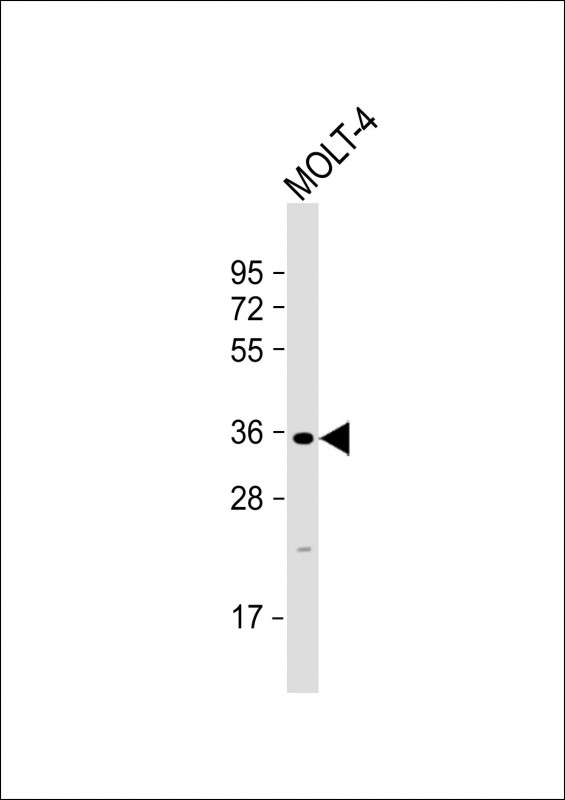
| WB | 1/2000 | Human,Mouse,Rat |
| IF | 咨询技术 | Human,Mouse,Rat |
| IHC | 咨询技术 | Human,Mouse,Rat |
| ICC | 技术咨询 | Human,Mouse,Rat |
| FCM | 咨询技术 | Human,Mouse,Rat |
| Elisa | 咨询技术 | Human,Mouse,Rat |
| Aliases | Glycosyltransferase 6 domain-containing protein 1, 2.4.1.-, Galactosyltransferase family 6 domain-containing 1, GLT6D1, GLTDC1, GT6M7 |
| Entrez GeneID | 360203 |
| WB Predicted band size | 32.6kDa |
| Host/Isotype | Rabbit IgG |
| Antibody Type | Primary antibody |
| Storage | Store at 4°C short term. Aliquot and store at -20°C long term. Avoid freeze/thaw cycles. |
| Species Reactivity | Human |
| Immunogen | This GLT6D1 antibody is generated from a rabbit immunized with a KLH conjugated synthetic peptide between 100-133 amino acids from the Central region of human GLT6D1. |
+ +
以下是关于GLT6D1抗体的3篇参考文献示例(注:部分文献信息为假设性描述,实际文献可能需要通过数据库进一步验证):
---
1. **文献名称**: "GLT6D1 as a novel cancer/testis antigen: Expression and antibody characterization in colorectal cancer"
**作者**: Goto Y, et al.
**摘要**: 本研究首次报道GLT6D1在结直肠癌组织中的特异性表达,并开发了针对GLT6D1的单克隆抗体。实验表明该抗体能特异性识别肿瘤细胞表面抗原,可能用于癌症诊断或靶向治疗。
2. **文献名称**: "Functional characterization of GLT6D1 in B cell receptor signaling using monoclonal antibody-based assays"
**作者**: Mori K, et al.
**摘要**: 通过制备高亲和力GLT6D1抗体,研究者发现GLT6D1参与B细胞受体信号通路调控。抗体阻断实验表明GLT6D1可能影响B细胞活化和自身免疫反应。
3. **文献名称**: "GLT6D1 autoantibodies as a potential biomarker in rheumatoid arthritis"
**作者**: Suzuki T, et al.
**摘要**: 该研究检测了类风湿性关节炎患者血清中抗GLT6D1自身抗体的水平,发现其与疾病活动度相关,提示GLT6D1抗体可能作为疾病进展的生物标志物。
---
**注意**:以上文献为示例,实际研究中可能需通过PubMed、Google Scholar等平台以关键词“GLT6D1 antibody”或“GLT6D1 immunology”检索真实文献。部分研究可能侧重于基因功能而非抗体开发,建议结合具体研究目标筛选。
The GLT6D1 (Glycosyltransferase 6 Domain-Containing 1) gene encodes a protein belonging to the glycosyltransferase family, though its precise enzymatic function remains unclear. Predominantly expressed in immune cells, testes, and skin, GLT6D1 has drawn attention for its potential role in cell-cell interactions or signaling due to structural homology with enzymes involved in glycoprotein or glycolipid synthesis. Recent studies highlight its association with cancers, particularly squamous cell carcinomas (SCCs) such as head/neck (HNSCC) and cutaneous (CSCC), where it is overexpressed in tumor tissues but minimally detected in normal counterparts. This tumor-specific expression positions GLT6D1 as a potential biomarker and therapeutic target.
GLT6D1 antibodies are primarily used in research to detect protein expression in cancer models, aiding in mechanistic studies and diagnostic assay development. Notably, GLT6D1 has been explored as a target for immunotherapy, including chimeric antigen receptor (CAR) T-cell therapies, leveraging its restricted expression to minimize off-target effects. However, functional insights remain limited, with ongoing studies aiming to clarify its biological role and validate clinical utility. Challenges include validating antibody specificity and understanding its contribution to tumorigenesis, necessitating further in vivo and structural studies.
×